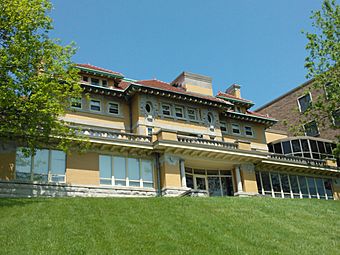Henry Kahl House facts for kids
Quick facts for kids |
|
|
Henry Kahl House
|
|

South facade
|
|
| Location | 1101 W. 9th St. Davenport, Iowa |
|---|---|
| Area | 5 acres (2.0 ha) |
| Built | 1920 |
| Architect | Arthur Ebeling |
| Architectural style | Mission/Spanish Revival |
| MPS | Davenport MRA |
| NRHP reference No. | 83002457 |
| Added to NRHP | July 7, 1983 |
The Henry Kahl House is a historic building in Davenport, Iowa. It sits high on a bluff, looking over the city's West End. This grand house was once a private home. Later, it became a nursing home in 1955. In 2016, it was changed again into apartments for older adults. The house was added to the National Register of Historic Places in 1983 because of its importance.
Who Was Henry Kahl?
Henry Kahl was born in a small house in Davenport. When he was just 12 or 13, he was already working. He drove a team of mules between Davenport and Coal Valley, Illinois. At 16, he started working for a construction company in Davenport. This company, P.T. Walsh, built railroads all over the United States.
Henry worked hard and moved up in the company. He became a vice president. He helped oversee big projects like the New York Central Railroad. His company also built a large tunnel system. This system moved water from the Colorado River to Southern California. They also built train stations in cities like Buffalo, New York and Erie, Pennsylvania.
By the time he was 45, Henry Kahl was a partner in the construction firm. He became a millionaire on his own. He used his money to invest in different companies and real estate. He bought land in downtown Davenport. On one piece of land, he built the famous Kahl Building. Henry Kahl passed away in 1931 when he was 56 years old.
History of the House
Henry Kahl had this house built for his family in 1920. It was designed in the Spanish Colonial Revival style. A Davenport architect named Arthur Ebeling designed it. He also designed the Kahl Building downtown.
Years later, in 1954, Henry Kahl's daughter, Elizabeth, and her husband, V.O. Figge, gave the house to the Catholic Diocese of Davenport. They wanted it to be used for charity. In 1955, a group of nuns called the Carmelite Sisters for the Aged and Infirm turned the house into a retirement home. It was called the Kahl Home for the Aged and Infirm. It started with 25 beds and was only for women.
In 1963, a new building and a chapel were added to the main house. This allowed the home to care for men too. Another addition in 1987 increased the number of beds to 135. The original house was used for the sisters' living space, offices, and guest rooms. In 2009, the Sisters decided to build a new facility. A new $40 million nursing home opened in 2012. The old Kahl Home was then empty.
In 2013, plans were announced to turn the old building into apartments for seniors. The building was bought by Gold Coast Housing LLC in 2015. The renovation started in March of that year. The main rooms of the mansion were updated for public use. The study became the manager's office. The lower level became one large apartment. The second and third floors were each turned into two apartments. The third floor used to be a ballroom. The main staircase was also restored. The additions from 1963 and 1987 were also renovated into many apartments. The whole project was finished in late 2016.
House Design and Look
The Henry Kahl House is 3½ stories tall. It is made of cream-colored brick. It combines the Spanish Revival and Mission Revival styles. The house sits high on a bluff. It has large, terraced grounds around it.
The house still looks much like it did originally. The east side was changed a bit to connect to the nursing home building. On the north side, there is a covered entrance for cars, called a Porte-cochère. The house also has tall chimneys with decorative concrete tops.
Other fancy details on the outside include decorations around oval windows. There is also a balcony with a railing. The house has stacked open porches with columns. The entire building is topped with multiple hipped roofs covered in red ceramic tiles.
Images for kids




